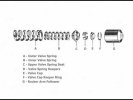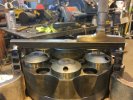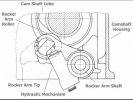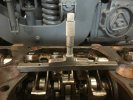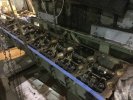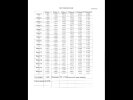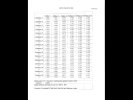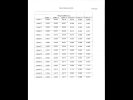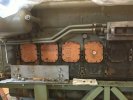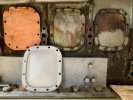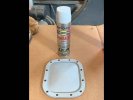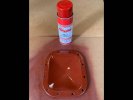Southern
Pacific 9010
Mechanical Work
Page 7
Page 7
-- Update May 29, 2020 --
An issue not previously addressed is that of valve clearances. Being an overhead camshaft engine, the cam followers are under the cams and there is no simple way of adjusting the clearance between a follower and its valve. In this engine, the terms "cam follower" and "rocker arm" are referring to the same item and may be used interchangeably. The only way to establish the proper valve clearance is through a complex set of measurements. In order to avoid buying expensive tools for the job, I made the jigs seen in photos 2 and 4. These jigs allow the use of a depth gauge for the measurements. The cylinder head measurement is from the top surface of the head to the top of the rocker follower. The cam box measurement is from the underside of the cam box to the tip of the rocker. Taking these two measurements plus a little math gives us the distance between the rocker arm and the rocker follower. This distance is adjusted by exchanging the valve cap, an item that is available in 8 different thicknesses. Does all this sound like fun?? Sixteen cylinders times 6 valves per cylinder is 96 measurements for the heads alone. Add to that the 96 measurements needed for the cam followers and one winds up with a lot of work that is required to keep a happy Maybach. Included below for your entertainment are the records generated by all that time spent measuring.
With all of the liners installed and the oil lines aligned, it was time to pressurize the cooling water system to see if there were any liner leaks. Needless to say, there are proper tools available for this operation but also needless to say, it was not necessary to buy 16 of them when we had the cylinder heads available. Photo #1 is of that special tool. It is designed to hold the cylinder liner in place and plug the 5 passages that pass water from the engine block to the cylinder head. One per cylinder would be required to do the cooling system pressure test. Rather than buy these special tools, we decided to simply install the heads. Granted that using the heads will add some work to the operation as they are very heavy but our air winch mitigates that problem quite nicely. We also had to plug the cooling water connections to the turbochargers and the inlets and outlets of the water pumps.
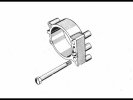 |
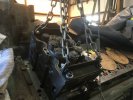 |
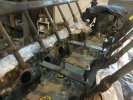 |
Since the test water is supposed to be heated and kept at 15psi over normal pressure, we elected to remove the pre-heater from the locomotive and use it for the water test. The pre-heater draws water from a tub and sends it into the block through the water inlet manifold. It exits the block through the water jumpers attached to each head. The water is then fed back to the tub through a valve by which we can control the pressure. The first test we did was with cold water at 30psi. After this was completed successfully, we heated the water to 135F and again ran the pressure up to 30psi. Once this test was in the books, we drained the hot water and allowed the block to dry out.
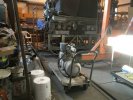 |
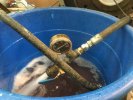 |
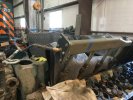 |
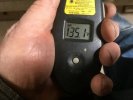 |
Here's Karl having a
look through the crankcase for any water leaking. We had to
carefully examine the inside of the liners as well as the mating
surfaces between the heads and the block.
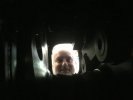 |
While not strictly
mechanical, I will put the little item in here so as not to lose the
continuity of the project. 9010 was originally equipped with
a National Safety Appliance Company's Automatic Train Stop (ATS)
system. The most visible part of this apparatus was
the "Duplex Magnet Control Valve" that hung under the front
end of the locomotive. We have been kicking this around for
years but have never found good photographs of the valve or better yet,
a complete valve. I decided to fabricate something
that would give an idea of what the device looked like and
our resident
forensicologist, Bob Zenk, created the plans.
Much of the layout and
piece work was done at the home shop during the virus lock down.
The following
photographs were taken of the creative process.
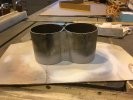 |
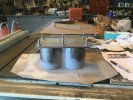 |
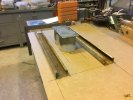 |
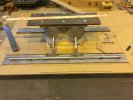 |
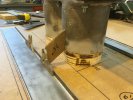 |
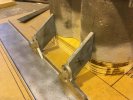 |
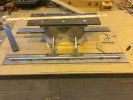 |
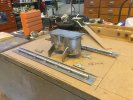 |
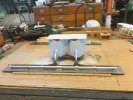 |
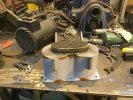 |
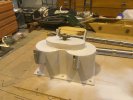 |
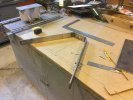 |
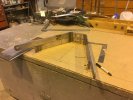 |
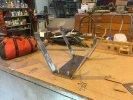 |
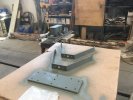 |
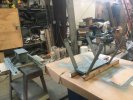 |
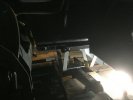 |
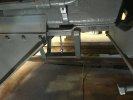 |
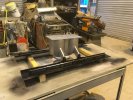 |
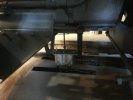 |
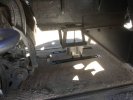 |
The next job on the Maybach would be reinstalling all of the piston and rod assemblies. Here is fork rod assembly #9 all taken apart for cleaning. New oil control rings will be installed on the piston before installation. The rod bolts have splines as do the rod nuts. The nuts and washers must be put back on the bolts from which they came so the nuts are stamped with numbers that correspond with locations on the rod caps. After this one is in place, the #1 blade rod will be next on the list.
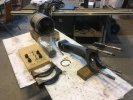 |
--
Update July 02, 2020 --
These are a few more photos of the #9 piston and its fork rod. The plastic tubes seen covering the rod bolts are there for two reasons. First, they protect the crank journal against being scratched by the rod bolts and they also hold the cut washers in place. The washers are there to prevent the rod's upper bearing shell from falling out of the rod as they are very heavy and need some help staying in place. . The shell's bearing surface is lubricated with a good quality assembly lubricant. The third and fourth photos show the ring compressor.
These are a few more photos of the #9 piston and its fork rod. The plastic tubes seen covering the rod bolts are there for two reasons. First, they protect the crank journal against being scratched by the rod bolts and they also hold the cut washers in place. The washers are there to prevent the rod's upper bearing shell from falling out of the rod as they are very heavy and need some help staying in place. . The shell's bearing surface is lubricated with a good quality assembly lubricant. The third and fourth photos show the ring compressor.
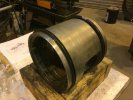 |
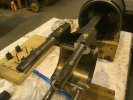 |
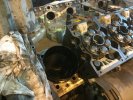 |
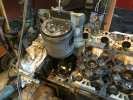 |
Here is piston/blade
rod #1 which is the mating assembly for #9. The piston pin is
removed to clean and lubricate the pin, piston and
rod.. Having the pin out and the piston off of the rod makes
it easier to install the bottom oil control ring without scratching the
piston. The last photo is of the peg board I used to keep
track of the rod nuts and washers.
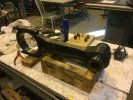 |
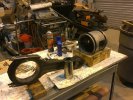 |
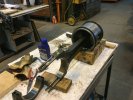 |
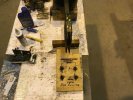 |
This is a photo of
the underside of a piston top. The lettering shows that the
piston was purchased from MAHLE GmbH, one of the largest automotive
suppliers in the world. Even a diversified manufacturer like
Maybach could not produce everything. Second photo is looking
down into a cylinder that has yet to receive the blade rod.
The light ring is caused by a camera flash. And
here is some guy celebrating the last piston to be installed.
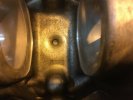 |
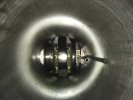 |
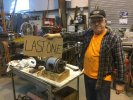 |
After all of the
pistons and rod
assemblies were in, the next step would have been to tighten the rod
bolts but we could not do this because we were waiting for some special
wrenches. That process will be covered later. We
turned to
dealing with the "crush rings". The Maybach does not use a
head
gasket as such. It has a copper coated cast iron ring that
sits
in a groove between the cylinder liner and the block. The
depth
of each of the 16 grooves had to be measured and recorded.
Once
all of them were measured, crush rings of the proper thickness could be
chosen. One at a time, the proper ring was installed in a
groove,
the head installed and a measurement taken of the distance between the
head and the block, at all 4 surfaces - front, left, back and right.
This distance had to be between .003" and .005".
Once the
measurement was noted, the head was partially torqued down and the
measurement repeated. As long as the distance did not
compress to
less than .003", all was good. We were very fortunate that
all 16
of the measurements fell within the normal bounds of a 4.4mm (.173")
thick crush ring. We had a selection of rings to use for test thanks to
our crew member Rob Fern from the UK. All of this
measuring work resulted in the chart seen in photo #3.
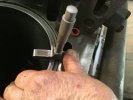 |
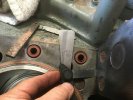 |
 |
--
Update August 12, 2020 --
Karl has been busy with a project on the engine crankcase. There are 16 inspection doors, one for each cylinder. These doors and their studs have been a source of oil leaks. Karl is removing all 16 studs from each door opening, cleaning the studs, cleaning the holes and then putting the studs back using a good thread sealer. While the studs are out of the block, he has cleaned the sealing surface of the old gasket material. The door are getting a much needed bead blasting and then paint on the outside and a coat of Glyptal on the inside. Hopefully, we will eliminate the oil leaks that used to affect the doors.
With the arrival of the long handled connecting rod bolt tools, we were able to start tightening the bolts. These bolt are not tightened to a torque specification but rather to a measurement of stretch. At the factory, a technician would mount the rod with its bearing and caps in a vise. The nuts would be tightened while watching an instrument that was measuring the amount each bolt stretched under tension. When the proper amount of stretch was achieved, the end of the rod bolt and nut were marked with a sort of chisel. Our challenge was to return those marks to their proper alignment on each bolt and nut combination. The first thing to do was put ink marks on the notches in the nuts and bolts so the notches would be easier to see. The 4th photo shows one of the wrenches on the serrated nut. In this case, the other wrench would be holding the rod bolt from the other side of the block while one of us tightens the nut. Needless to say, getting photos of this operation was difficult. The wrenches are used to tighten the rod bolt nuts on one side of the rod while our "T" handle wrenches are used to tighten the other nuts. In an ideal situation, the engine block would be mounted in a rotisserie engine stand which would hold the block straight up in the air and one could use the "T" handle wrenches on all of the rod bolts and nuts. Karl worked on the left side while I worked on the right. We came up with a system that works quite well.
Karl has been busy with a project on the engine crankcase. There are 16 inspection doors, one for each cylinder. These doors and their studs have been a source of oil leaks. Karl is removing all 16 studs from each door opening, cleaning the studs, cleaning the holes and then putting the studs back using a good thread sealer. While the studs are out of the block, he has cleaned the sealing surface of the old gasket material. The door are getting a much needed bead blasting and then paint on the outside and a coat of Glyptal on the inside. Hopefully, we will eliminate the oil leaks that used to affect the doors.
With the arrival of the long handled connecting rod bolt tools, we were able to start tightening the bolts. These bolt are not tightened to a torque specification but rather to a measurement of stretch. At the factory, a technician would mount the rod with its bearing and caps in a vise. The nuts would be tightened while watching an instrument that was measuring the amount each bolt stretched under tension. When the proper amount of stretch was achieved, the end of the rod bolt and nut were marked with a sort of chisel. Our challenge was to return those marks to their proper alignment on each bolt and nut combination. The first thing to do was put ink marks on the notches in the nuts and bolts so the notches would be easier to see. The 4th photo shows one of the wrenches on the serrated nut. In this case, the other wrench would be holding the rod bolt from the other side of the block while one of us tightens the nut. Needless to say, getting photos of this operation was difficult. The wrenches are used to tighten the rod bolt nuts on one side of the rod while our "T" handle wrenches are used to tighten the other nuts. In an ideal situation, the engine block would be mounted in a rotisserie engine stand which would hold the block straight up in the air and one could use the "T" handle wrenches on all of the rod bolts and nuts. Karl worked on the left side while I worked on the right. We came up with a system that works quite well.
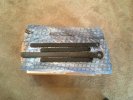 |
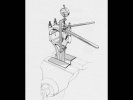 |
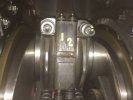 |
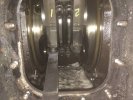 |
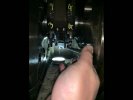 |
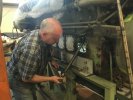 |
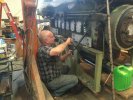 |
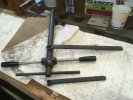 |
--
Update December 12, 2020 --
With all of the rod bolts tightened, we were able to clean out the lower part of the block and re-install the oil pan. Karl took on the job of cleaning the gasket surface on the block and putting the oil pickups back on. When this work was done, I put all of the windage trays back on. This completed our work on the lower part of the engine block so we turned our attention to the oil pan.
Preparing the pan included wiping it out with mineral spirits and while doing so, I noticed a drip or 2 on the shop floor. An examination of the pan bottom revealed that there were 2 corroded areas in the metal and several spots where the metal had rotted all the way through. How the pan did not leak oil is a mystery but there were probably chunks of crud plugging the holes. I made an attempt to braze the bad areas but this was not successful due to cracking of the base material. Karl is seen cleaning the base metal before I made patches and MIG welded them over the entire corroded areas. Submerging the areas in water for several hours with no leaking proved the repair.
With all of the rod bolts tightened, we were able to clean out the lower part of the block and re-install the oil pan. Karl took on the job of cleaning the gasket surface on the block and putting the oil pickups back on. When this work was done, I put all of the windage trays back on. This completed our work on the lower part of the engine block so we turned our attention to the oil pan.
Preparing the pan included wiping it out with mineral spirits and while doing so, I noticed a drip or 2 on the shop floor. An examination of the pan bottom revealed that there were 2 corroded areas in the metal and several spots where the metal had rotted all the way through. How the pan did not leak oil is a mystery but there were probably chunks of crud plugging the holes. I made an attempt to braze the bad areas but this was not successful due to cracking of the base material. Karl is seen cleaning the base metal before I made patches and MIG welded them over the entire corroded areas. Submerging the areas in water for several hours with no leaking proved the repair.
 |
 |
 |
 |
 |
 |
 |
 |
 |
Karl cleaned the top
edge of the pan, applied a coat of Permatex #2 and we put the pan back
in place. All 88 pan nuts were torqued and we turned our
attention to the side covers. Karl had previously cleaned all
of the covers and block gasket surfaces. All of the studs
were removed, cleaned and reinstalled with sealer as the studs
penetrate into the inside of the block and many were seen to have been
leaking. New gaskets were applied with the covers and the
nuts properly torqued.
 |
 |
 |
Bill has been working
on the exaust elbows. He cleaned them all, and applied new
sealing rings to the sealing inserts. These inserts go up
into the bottom of the turbochargers and are intended to provide an
exhaust gas seal.
 |
 |
 |
 |
Return To Main Page
